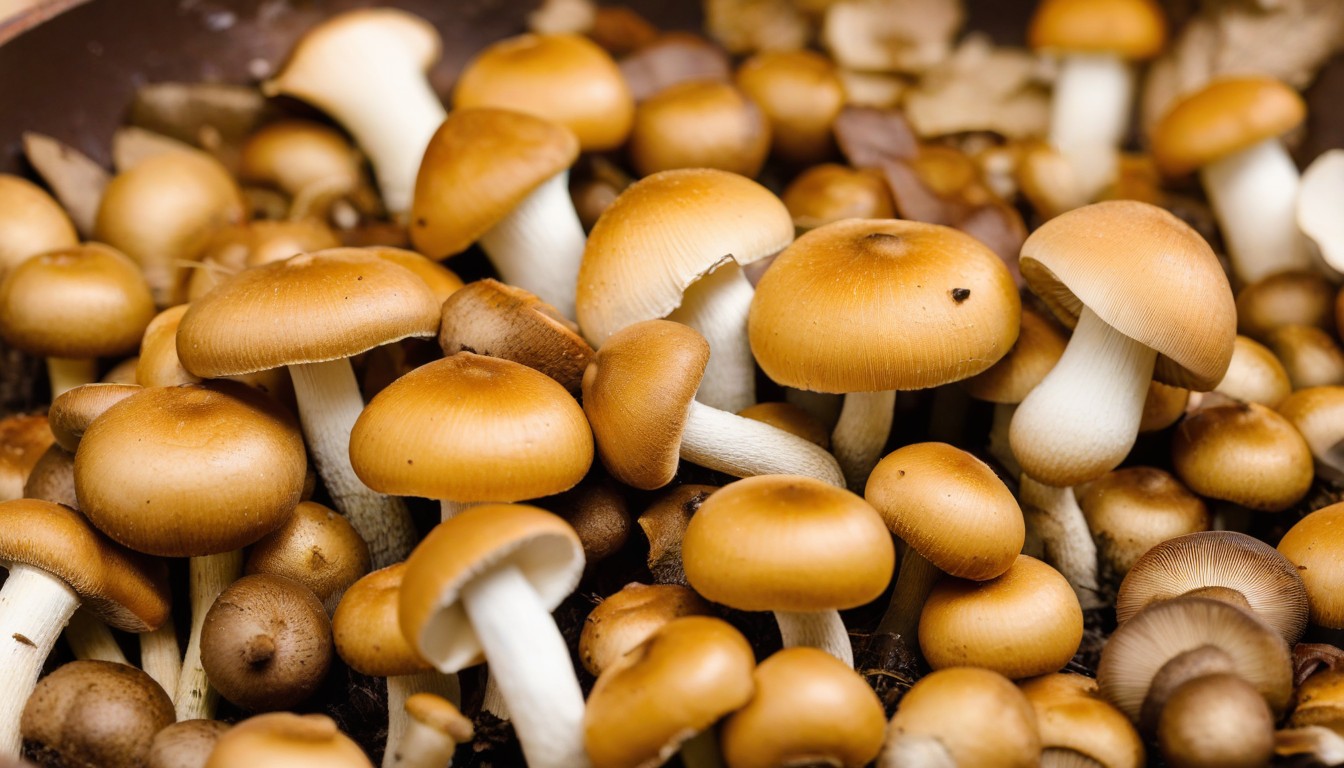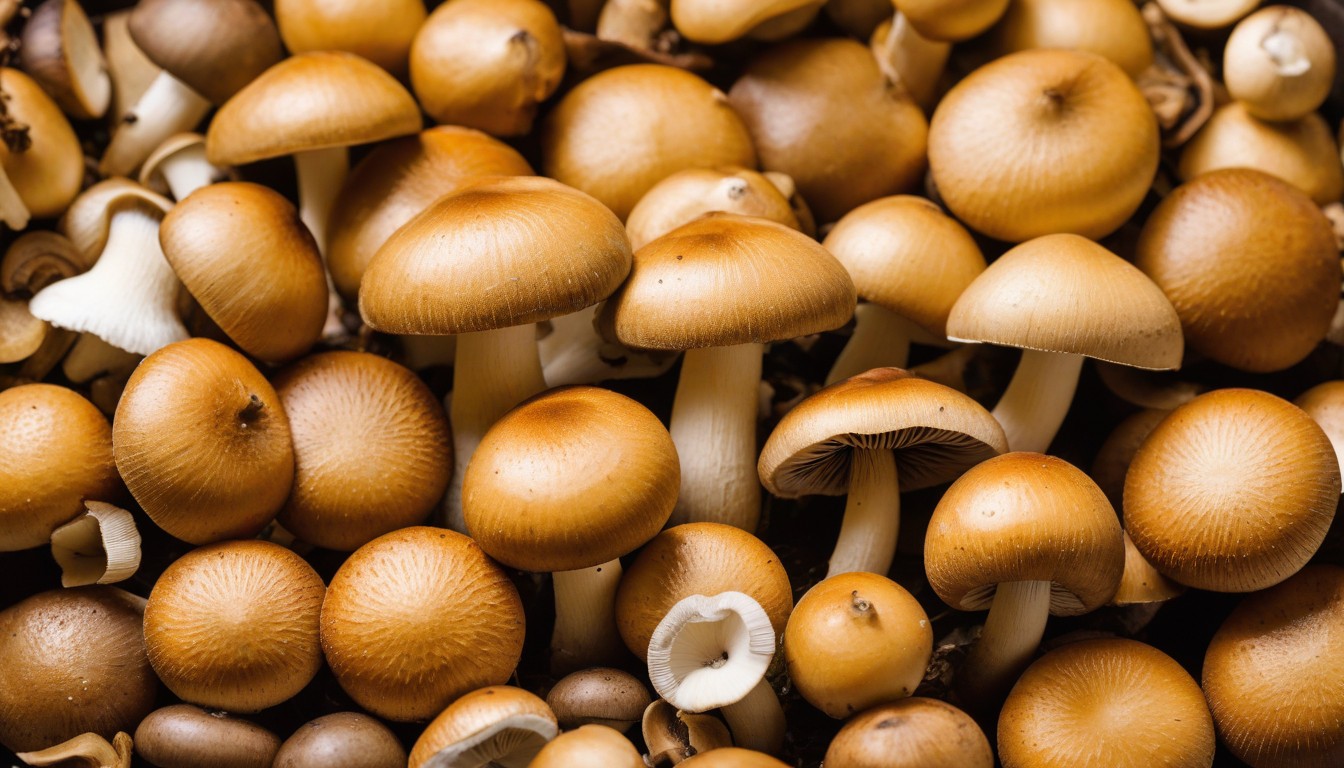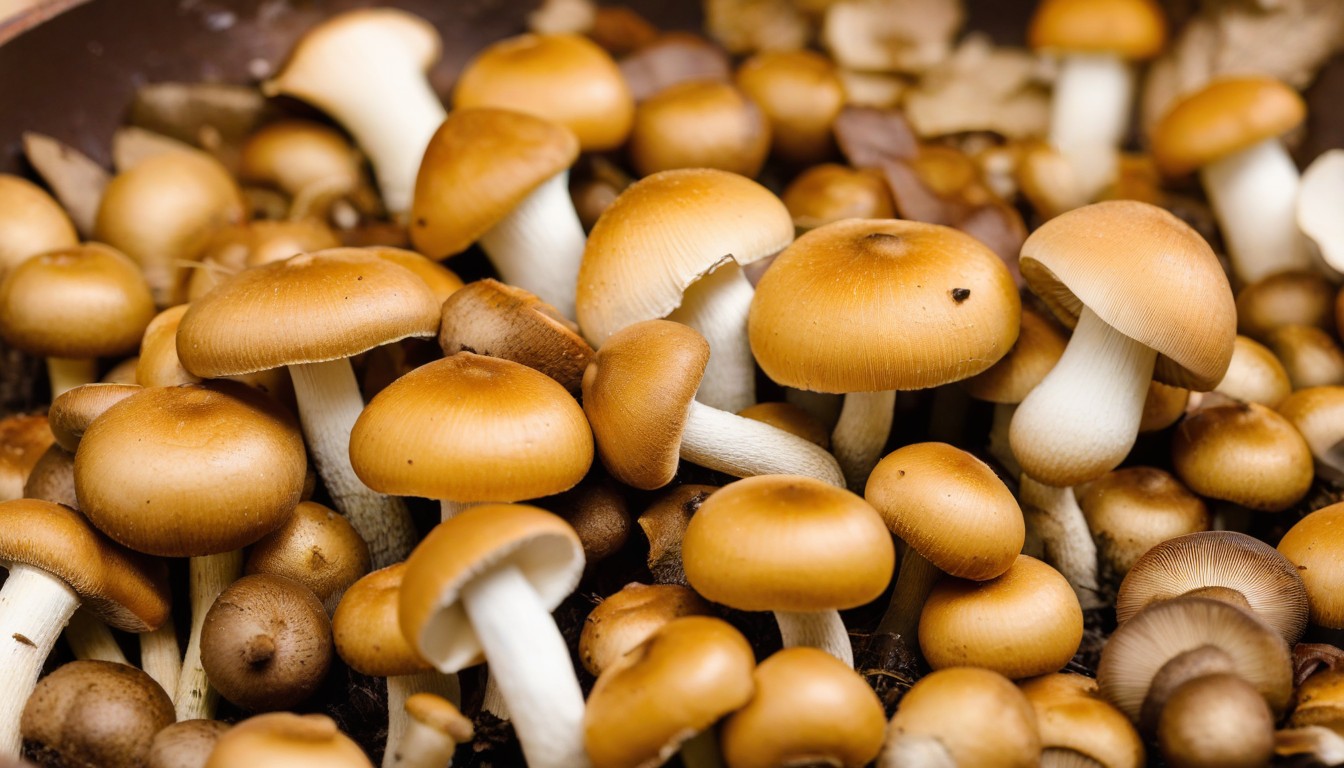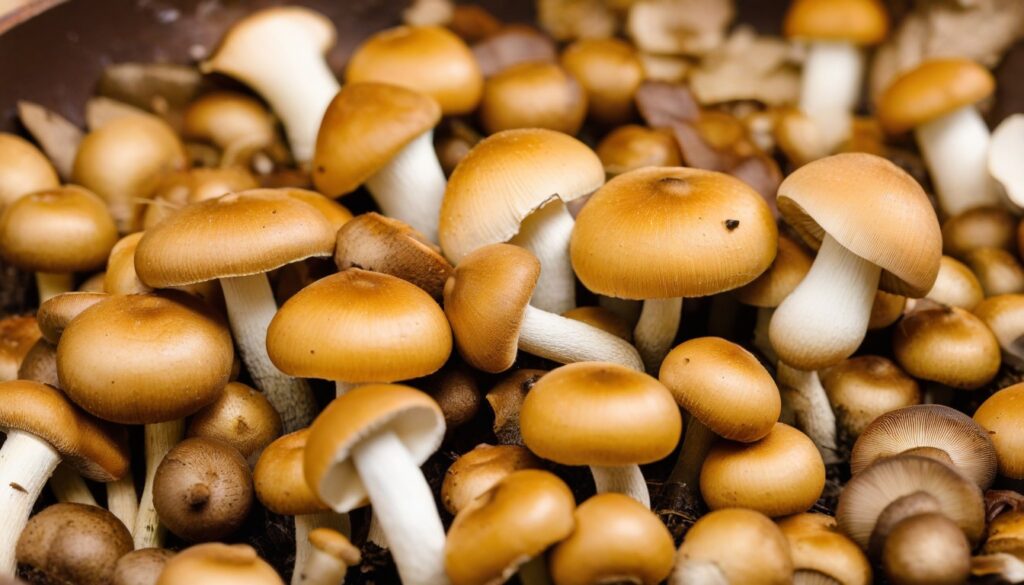If you are looking to elevate your culinary skills and explore new flavors, fermenting mushrooms at home is an easy and effective way to do so. Not only does it enhance the taste and texture of mushrooms, but it also increases their nutritional value. In this article, we’ll dive into the simple techniques of fermenting mushrooms and discover the numerous benefits they provide.
Key Takeaways:
- Fermenting mushrooms is an easy and accessible technique that can improve both flavor and nutritional value.
- Fermentation is a natural preservation method that has been used for centuries.
- The basic techniques of fermenting mushrooms include brine fermentation, dry fermentation, and secondary fermentation.
- Flavoring options for fermented mushrooms are endless, from garlic and herbs to spices and other vegetables.
- Fermented mushrooms can be stored and preserved for long-term use, making them a versatile and valuable ingredient in the kitchen.
Benefits of Fermenting Mushrooms
Fermenting mushrooms is a simple and effective way to unlock a plethora of benefits that can elevate your culinary creations. By fermenting mushrooms, you enhance their flavor, texture, and nutritional value, making them a valuable addition to your diet. Here are some of the benefits of fermenting mushrooms:
|
Benefits |
Description |
|---|---|
|
Enhanced Flavor |
Fermenting mushrooms can add a tangy, umami flavor that complements a wide range of dishes. |
|
Increased Nutritional Value |
Fermenting mushrooms can produce valuable enzymes, vitamins, and probiotics that can boost your immune system and improve your digestion. |
|
Improved Digestion |
The probiotics produced during fermentation can help to balance the gut microbiome and improve digestion. |
Whether you’re a seasoned chef or a curious kitchen experimenter, fermenting mushrooms is a great way to add depth and complexity to your culinary repertoire. In the following sections, we will show you how to get started with fermenting mushrooms, explore the best techniques and ingredients, and offer some delicious ideas for enjoying the fruits of your fermentation labor.
Getting Started with Fermenting Mushrooms
Before diving into the world of fermenting mushrooms, it’s important to know the basic equipment and ingredients you’ll need to get started. Here’s a breakdown:
Equipment
|
Equipment |
Description |
|---|---|
|
Glass jars with lids |
The best vessels for fermenting mushrooms are glass jars, as they are non-reactive and won’t leach harmful chemicals into your food. Wide-mouth jars are recommended for ease of packing and cleaning. |
|
Fermentation weights |
These are small weights that go inside the jar to keep the mushrooms submerged in the brine, preventing mold growth. |
|
Airlocks and lids |
While not essential, airlocks and lids can help regulate the amount of air in the jar, reducing the risk of mold and ensuring consistent fermentation. |
Ingredients
The two main ingredients for fermenting mushrooms are mushrooms themselves and a salt brine solution. Here’s what you’ll need:
- Mushrooms: Any type of mushroom can be fermented, but some varieties work better than others. Shiitake, oyster, and button mushrooms are great choices for starters.
- Salt: Use high-quality, non-iodized salt for the best results. Kosher salt, sea salt, or Himalayan pink salt are all good options.
- Filtered water: Chlorine and other chemicals in tap water can interfere with the fermentation process, so it’s best to use filtered or spring water.
- Optional flavorings: You can add garlic, herbs, spices, or other vegetables to the brine for additional flavor and nutrition.
Once you have your equipment and ingredients ready, it’s time to prepare your mushrooms for fermentation. Clean the mushrooms thoroughly and trim off any tough stems or debris. Depending on the type of mushroom, you can slice or leave them whole.
Now that you’re equipped with the knowledge you need to get started, it’s time to roll up your sleeves and start fermenting. Get ready to taste the delicious and nutritious results of your hard work!
Basic Fermentation Techniques for Mushrooms

Learning the basic fermentation techniques for mushrooms is essential to achieving perfectly preserved and flavorful fungi. Below, we explore three popular techniques that can be easily mastered at home to add depth and complexity to your mushroom dishes.
Brine Fermentation
Brine fermentation is a popular technique used to create pickled mushrooms with a tangy, salty flavor. It involves submerging your mushrooms in a saltwater solution, and can be done with whole or sliced mushrooms. Follow these simple steps for successful brine fermentation:
- Sanitize a wide-mouth glass jar and lid with boiling water or with a sterilizing solution.
- Prepare your mushrooms by trimming off any tough stems and slicing them (if desired).
- Make the brine by dissolving salt in filtered or spring water (1-2 tablespoons of salt per cup of water).
- Pack the mushrooms into your prepared jar and pour the brine over them until they are fully submerged.
- Weigh the mushrooms down with a small lid or a fermentation weight to keep them fully submerged in the brine.
- Cover the jar with a breathable cloth to keep out dust and insects while allowing for air circulation.
- Wait until your mushrooms reach your desired level of sourness, which can take anywhere from a few days to several weeks depending on your taste preferences and the temperature of your kitchen.
- Once they are fermented to your liking, store your mushrooms in the fridge or another cool, dry place for up to several months.
Dry Fermentation
Dry fermentation involves tossing your fresh mushrooms with salt and allowing them to naturally release their own liquid to form a brine. This technique works best with mushrooms that have a high moisture content. Follow these simple steps for successful dry fermentation:
- Sanitize a non-metallic container.
- Clean and prepare your mushrooms by cutting larger mushrooms into smaller pieces and removing any bad spots.
- Add the mushrooms to your container.
- Massage salt into the mushrooms (use 2 – 3% of the mushroom weight).
- Cover the container with a breathable cloth, and allow the mushrooms to sit at room temperature for 1 or more days.
- As the mushrooms release their own liquid, you’ll notice a natural brine forming around them. If there isn’t enough brine to completely cover the mushrooms, you can top them off with a bit of saltwater.
- Continue fermenting your mushrooms until they reach your desired level of sourness, which can take anywhere from a few days to several weeks.
- Once they are fermented to your liking, store your mushrooms in the fridge or another cool, dry place for up to several months.
Secondary Fermentation
This technique is used to create more complex flavors by adding other ingredients such as herbs, garlic, or onions to your already fermented mushrooms. It’s done after primary fermentation has taken place, and requires just a few additional steps:
- Clean and prep your desired additional ingredients.
- Add any desired ingredients to your already fermented mushrooms.
- Return the jar to room temperature and allow the flavors to meld for up to a few days.
- Once the additional flavors have infused, store your mushrooms in the fridge or another cool, dry place for up to several months.
Flavoring Options for Fermented Mushrooms

One of the best things about fermenting mushrooms is the ability to add a variety of flavors to your dish. Here are some options to consider:
|
Flavoring Option |
Description |
|---|---|
|
Garlic |
Adding minced or roasted garlic to your mushroom fermentation can add a bold and savory taste to your dish. |
|
Herbs |
Try adding fresh or dried herbs like thyme, rosemary, or basil to give your mushrooms a fragrant and aromatic touch. |
|
Spices |
A pinch of cumin, coriander, or paprika can not only add some heat to your dish but also a hint of smokiness as well. |
|
Vegetables |
Adding other vegetables like carrots, onions, or peppers can provide extra nutrients and a complementary taste to your mushrooms. |
Keep in mind that some flavors may overpower the delicate taste of the mushrooms, so be careful not to add too much. Start with small amounts and taste as you go.
Pro-tip: Try mixing and matching flavor combinations until you find the perfect one that suits your taste buds!
Troubleshooting Common Issues in Mushroom Fermentation
Fermenting mushrooms is a straightforward process, but sometimes issues can arise that interfere with the success of the fermentation. Here are some of the most common problems and their troubleshooting solutions:
|
Issue |
Solution |
|---|---|
|
Mold growth |
Discard any contaminated mushrooms and transfer the remaining fermented mushrooms to a new vessel. Ensure all equipment is thoroughly cleaned and sanitized before proceeding. |
|
Foul odor |
Smell the mushrooms to identify the source of the odor. It may be due to improper preparation or a bacterial contamination. If it is a bacterial contamination, discard the batch and start fresh. |
|
Off-flavors |
Off-flavors can occur due to a variety of reasons, including the use of overripe mushrooms, incorrect salt ratios, or poor fermentation conditions. Experiment with different variables and adjust your technique until you achieve your desired flavor. |
|
No bubbles |
Lack of bubbles can indicate that the fermentation process is not active. Ensure that the proper conditions are met, such as consistent temperature, sufficient oxygen, and the addition of starter culture, if necessary. |
With the above troubleshooting solutions, you can successfully prevent and overcome issues during the mushroom fermentation process and enjoy delicious, flavorful fermented mushrooms.
Storing and Preserving Fermented Mushrooms

After successfully fermenting your mushrooms, it’s important to store them properly to maintain their flavor and nutritional value for long-term enjoyment. Follow these best practices for storing and preserving your fermented mushrooms:
Storage Containers
Choose storage containers that are clean and airtight to prevent mold growth. Glass jars with clamp lids, ceramic crocks, or resealable bags are all great options for storing fermented mushrooms.
|
Container Type |
Pros |
Cons |
|---|---|---|
|
Glass jars with clamp lids |
Easy to find, visually appealing, reusable |
May be heavy, may break if dropped |
|
Ceramic crocks |
Stylish, durable, allows for natural airflow |
May be heavy, can be expensive |
|
Resealable bags |
Lightweight, easy to store, inexpensive |
May not be as airtight as other options, not visually appealing |
Refrigeration
Refrigeration is the most common way to store fermented mushrooms. Place your mushrooms in an airtight container and store them in the refrigerator for up to six months. If you notice any mold growth, discard the mushrooms immediately.
Freezing
If you want to store your fermented mushrooms for longer than six months, consider freezing them. Place the mushrooms in an airtight container or resealable bag and freeze for up to a year. When you’re ready to use them, thaw the mushrooms in the refrigerator and use them within a week.
By following these storage and preservation techniques, you can ensure that your fermented mushrooms stay fresh and delicious.
Culinary Uses for Fermented Mushrooms
Once you’ve successfully fermented your mushrooms, the possibilities for incorporating them into your cooking are endless. Here are just a few culinary uses to get you started:
|
Dish |
Culinary Use |
|---|---|
|
Salad |
Add fermented mushrooms to a salad with fresh greens, nuts, and a vinaigrette dressing. |
|
Stir-fry |
Toss fermented mushrooms into a stir-fry with your favorite protein and veggies. |
|
Soup |
Add fermented mushrooms to a hearty soup, such as miso or mushroom and barley soup. |
|
Pizza |
Top your pizza with fermented mushrooms for a delicious umami flavor. |
Experiment with incorporating your fermented mushrooms into your favorite dishes, or try creating a new recipe to showcase their unique flavor. You’ll be amazed at how versatile they can be and how much depth they add to your cooking.
Health Benefits of Fermented Mushrooms
Fermented mushrooms aren’t just incredibly tasty, but they also offer various health benefits. Here are some of the reasons why you should consider including them in your diet:
|
Health Benefit |
Description |
|---|---|
|
Improved gut health |
Fermented mushrooms contain probiotics that can aid digestion and promote the growth of good bacteria in the gut. This can improve regularity, reduce bloating and discomfort, and enhance overall gut health. |
|
Increased immune support |
The fermentation process can increase the bioavailability of nutrients in mushrooms, such as beta-glucans, which can boost the immune system and reduce inflammation. |
|
Potential anti-inflammatory properties |
Some studies suggest that fermented mushrooms may have anti-inflammatory effects, potentially reducing the risk of chronic illnesses such as heart disease, cancer, and arthritis. |
Incorporating fermented mushrooms into your meals can be a great way to enjoy their unique flavor while reaping the numerous health benefits they have to offer.
Conclusion
Fermenting mushrooms is a rewarding and accessible technique that can enhance the flavor and nutritional profile of this versatile ingredient. By following the simple methods outlined in this article, you can unlock the secrets of fermenting mushrooms at home and elevate your culinary creations to new heights.
Experiment with different types of mushrooms and flavorings to discover your own unique combinations. Not only will fermented mushrooms add depth to your recipes, but they also offer numerous health benefits, including improved gut health and increased immune support.
Don’t be intimidated by the fermentation process. As you continue to practice and experiment, you’ll gain confidence and expertise in this ancient preservation method. So go ahead, give it a try, and enjoy the delicious rewards of fermenting mushrooms at home.
FAQ
What are the benefits of fermenting mushrooms?
Fermenting mushrooms enhances their flavor, increases their nutritional value, and improves digestion.
How do I get started with fermenting mushrooms?
To get started, you’ll need essential equipment and ingredients. Choose the right mushrooms and prepare them properly for fermentation.
What are the basic fermentation techniques for mushrooms?
The basic fermentation techniques for mushrooms include brine fermentation, dry fermentation, and secondary fermentation. We provide step-by-step instructions on how to use these methods.
What are the flavoring options for fermented mushrooms?
You can infuse your fermented mushrooms with various flavors such as garlic, herbs, spices, and even other vegetables. Get creative with your flavor combinations!
What are some common issues in mushroom fermentation and how can I troubleshoot them?
Common issues in mushroom fermentation include mold growth and off-flavors. We provide tips on how to identify and overcome these challenges.
How should I store and preserve my fermented mushrooms?
Learn the best practices for storing and preserving your fermented mushrooms for long-term enjoyment. Discover proper storage containers and techniques like refrigeration and freezing.
What are the culinary uses for fermented mushrooms?
Fermented mushrooms can be added to salads, stir-fries, soups, and even used as a pizza topping. Use your imagination to incorporate them into a variety of dishes.
What are the health benefits of fermented mushrooms?
Fermented mushrooms can improve gut health, boost immune support, and potentially have anti-inflammatory properties. Discover the benefits of incorporating them into your diet.

